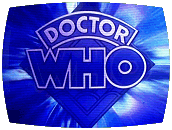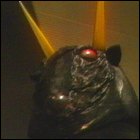 Romana emerges from the transmat pod on the planet Crinoth, and is immediately surrounded by more Nimon…until she finds that she’s not the only one on Crinoth who isn’t a Nimon. Sezom, Soldeed’s predecessor, has been trapped here, and has spent years evading the Nimon on their home planet – a ruined husk of a world that they now seek to escape by invading another world. Sezom helps her get back to the pod and return to Skonnos. Soldeed has now learned that the Nimon lied when it claimed to be the last of its race, but in the course of trying to do the Nimon’s bidding, accidentally sets the Nimon’s power systems to overload. The Doctor and friends must now rely on K-9 to help them find their way out of the maze before the Nimon complex destroys itself.
Romana emerges from the transmat pod on the planet Crinoth, and is immediately surrounded by more Nimon…until she finds that she’s not the only one on Crinoth who isn’t a Nimon. Sezom, Soldeed’s predecessor, has been trapped here, and has spent years evading the Nimon on their home planet – a ruined husk of a world that they now seek to escape by invading another world. Sezom helps her get back to the pod and return to Skonnos. Soldeed has now learned that the Nimon lied when it claimed to be the last of its race, but in the course of trying to do the Nimon’s bidding, accidentally sets the Nimon’s power systems to overload. The Doctor and friends must now rely on K-9 to help them find their way out of the maze before the Nimon complex destroys itself.
written by Anthony Read
directed by Kenny McBain
music by Dudley SimpsonCast: Tom Baker (The Doctor), Lalla Ward (Romana), David Brierly (voice of K9), Simon Gipps-Kent (Seth), Janet Ellis (Teka), Graham Crowden (Soldeed), Michael Osborne (Sorak), Malcolm Terris (Co-pilot), Bob Hornery (Pilot), Clifford Norgate (Nimon voices), John Bailey (Sezom), Robin Sherringham, Bob Appleby, Trevor St. John Hacker (Nimon)
Notes: The Nimon return to do battle with the Doctor in the Big Finish audio story Seasons Of Fear. The eleventh Doctor would encounter a species related to the Nimon in The God Complex (2011). Though intended to be followed by the six-part story Shada, The Horns Of Nimon was the final season 17 episode to be broadcast, and therefore marks the end of producer Graham Williams’ tenure, as well as being the final use in the original series of Delia Derbyshire’s arrangement of the theme music, which had been opening each episode of Doctor Who since 1963, sometimes in edited and lightly remixed forms. (It would next be heard at the beginning of The Day Of The Doctor (2013). This is also composer Dudley Simpson’s final musical contribution to the series for which he had been creating music since 1964’s Planet Of Giants.
LogBook entry & review by Earl Green
Review: There’s a lot of “received wisdom” floating around in Doctor Who fandom – certain stories are brilliant, and certain stories are crap, and other stories are even worse than that. The funny thing is, this wisdom ebbs and flows like the tides. Some stories once highly regarded are now considered crap (the 1996 TV movie seems to have suffered this fate, and I’ve never been quite sure exactly why). The Horns Of Nimon is one of those stories that seems to be perennially regarded as worse than crap. But if the character of the Doctor is about anything at all, he’s about not going with the status quo, so with that in mind, I thought I would watch The Horns Of Nimon afresh for the first time in what is probably 20 years, just to see if it’s really that bad. Fandom these days seems to regard Nimon as the nadir of Tom Baker’s era, a point at which the show had to make a major course correction (in the form of the radically different 18th season) to survive. Is it really that much of a low point?
 One thing that the critics seem to latch onto is the sheer amount of silliness on display in Nimon‘s four episodes. Not only is this story the very height of Tom Baker’s flippancy toward anyone or anything that’s meant to pose a threat to him, defusing just about any dramatic tension that the story might be attempting to generate. It doesn’t help that, aside from the almost laughably unwieldly Nimon creatures, the chief “threat” in Nimon is Graham Crowden as Soldeed, a villain who’s so over-the-top that one would’ve been hard-pressed to take him seriously in a 1960s story.
One thing that the critics seem to latch onto is the sheer amount of silliness on display in Nimon‘s four episodes. Not only is this story the very height of Tom Baker’s flippancy toward anyone or anything that’s meant to pose a threat to him, defusing just about any dramatic tension that the story might be attempting to generate. It doesn’t help that, aside from the almost laughably unwieldly Nimon creatures, the chief “threat” in Nimon is Graham Crowden as Soldeed, a villain who’s so over-the-top that one would’ve been hard-pressed to take him seriously in a 1960s story.
However, there’s one thing to consider: this story’s timing. If you look at the broadcast dates, The Horns Of Nimon began airing just before Christmas and became the story that took Doctor Who into the 1980s. Keeping in mind the British tradition of the Christmas pantomime, should we even be attempting to take Nimon seriously? Any more seriously than, say, The Runaway Bride and its own over-the-top villain? Sure, the story is lightweight, but at this point, the show’s creators have since aknowledged that they were bowing to the whims of their star’s whimsical excesses. (Anyone who’s ever mourned the lack of Tom Baker in the Big Finish audio stories needs to rewatch Nimon, which hearkens from the height of Baker exercising his “star power” to change lines, stage directions and even whole story elements to his liking, and ask themselves if they’re up for more of that.)
Nimon also wasn’t intended to end the 17th season on the silly note that it did; it was meant to be followed by the slightly more dramatic Shada, a Douglas Adams six-parter which was never finished. At least until the eventual release of what Shada footage was shot, fans and critics built up Shada in their own minds, based on its mythical lost status and the pedigree of its author. Before his death, Adams stated that he didn’t think Shada would have turned out to be the lost classic that everyone assumed it to be – had it been completed and aired.
Perhaps what’s missing from The Horns Of Nimon isn’t so much the qualities of other classic Doctor Who stories; whats missing is context. The 17th season had many an egregiously humorous moment, and in that context, Nimon fits right in. It was also, whether designed that way or not, a holiday story, and at this point that wasn’t a time slot granted to “heavy” entertainment. In short, there isn’t a lot I can necessarily say in Nimon‘s defense…but in its proper context, I’m not sure the story’s earned quite the large number of brickbats that it seems to have drawn over the years.

